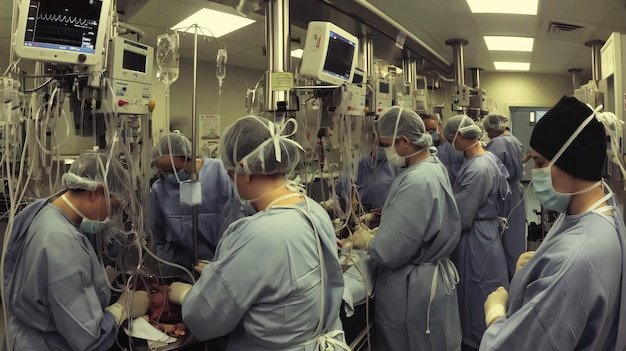In a recent study titled “Equal waiting times for all? Empirical evidence for elective surgeries in the Austrian public healthcare system,” a detailed examination of elective surgery wait times in Austria reveals significant insights into the functioning and fairness of the nation’s healthcare services. The research, conducted by M Kraus, B Stacherl, T Czypionka, and S Mayer, aims to understand the various factors influencing the length of time patients must wait before undergoing elective procedures such as hip and knee replacements. Considering the global scrutiny over health service accessibility, this study is timely and critical.
The researchers employed a retrospective patient questionnaire survey carried out in eleven Austrian rehabilitation centers in 2019. With responses from 400 participants further analyzed through bivariate tests and a more focused multivariate negative-binomial regression model from 310 cases, the study establishes a comprehensive base to ascertain patterns and anomalies in wait times. Reported median waiting times stood at 8.9 weeks for hip replacements and 8.4 weeks for knee replacements, durations that compare favorably against global benchmarks.
Interestingly, the study also explores the influence of supplementary private health insurance, physicians’ private practices visits, and even informal payments on shortening these wait times. Findings indicate that about 10.9% of surveyed patients were offered opportunities to reduce their waiting period through prior visits to the operating physician’s private practice or through direct informal payments. Moreover, factors such as opting for surgery in private for-profit hospitals and the severity of pain experienced by the patient were linked to shorter wait times.
This comprehensive analysis not only highlights the efficiency of elective surgery procedures in Austria’s public healthcare settings but also casts a light on potential disparities introduced by private health interventions. It raises pertinent questions on equitable access within a system designed for public benefit, providing a crucial platform for policy discussion and reform aimed at ensuring fair treatment across all socio-economic groups. As such, this study contributes significantly to the ongoing debate over healthcare equity and efficiency, particularly in the public sector.
Elective surgeries, often categorized as non-emergency procedures scheduled in advance, are a crucial element of healthcare systems worldwide. They can significantly affect a person’s quality of life by addressing conditions that, while not immediate life threats, can cause prolonged discomfort, disability, and deterioration in the quality of life. Understanding the dynamics and challenges associated with elective surgery wait times in different countries, such as Austria, provides insight into the broader health policy and resource allocation decisions that directly impact patient care and health outcomes.
In Austria, the healthcare system is renowned for its efficiency and comprehensive coverage, provided through mandatory health insurance for all residents. The system is financed through a combination of public funding and compulsory contributions from both employers and employees. Despite the robustness of the Austrian healthcare system, elective surgery wait times have emerged as a significant concern, with variances observed not only by procedure but also by region and the type of hospital. Such disparities are influenced by resource allocation, regional health policy, hospital management, and overall demand for surgical services.
Elective surgery wait times in Austria are subject to several factors including the aging population. As the demographics skew older, the demand for surgeries typically associated with aging, such as joint replacements and cataract surgeries, has seen a corresponding increase. This surge challenges the capacity of the healthcare system to maintain timely access to such procedures. Consequently, managing and optimizing surgical schedules and resources has become a pivotal aspect of healthcare administration in Austria.
The influence of technological advances in surgery and healthcare delivery also impacts elective surgery wait times. Innovations such as minimally invasive surgical techniques and improved pre- and post-operative care have the potential to reduce hospital stays and recovery times, theoretically increasing the throughput of surgical operations. However, the integration of such technologies varies by hospital and can be dependent on funding, training, and regional health policies, which in turn affects access and wait times.
Furthermore, the prioritization of elective surgeries often follows a triage system, where cases are ranked based on medical urgency. This system, while practical, relies heavily on transparent and equitable criteria to ensure that it does not inadvertently perpetuate or widen existing health disparities. For instance, socioeconomic status and regional living conditions can influence both the perceived urgency of cases and the ease of access to initial consultations, which can subsequently affect wait times.
Policy responses in Austria have included efforts to standardize wait times and increase transparency through public reporting and national targets for wait times for key elective procedures. Such initiatives are intended to mitigate long wait times by identifying bottlenecks in the system and allocating resources more efficiently. Moreover, there have been discussions around optimizing healthcare delivery through better integrated care pathways and enhanced coordination between different levels of the healthcare system.
In conclusion, elective surgery wait times in Austria mirror a complex interplay of demographic trends, technological advancements, healthcare policy, and system capacity. Addressing these wait times is not only about improving operational efficiencies but also about ensuring equitable access to necessary surgical care, thus enhancing the overall health outcomes for the Austrian population. As Austria continues to refine its healthcare system, ongoing research and policy adaptation will be essential in managing elective surgery wait times effectively, ensuring that the system remains responsive to the evolving healthcare needs of its population.
Methodology
Study Design
The research study was designed to investigate elective surgery wait times in Austria, focusing on how these durations are influenced by various factors such as healthcare policies, hospital resources, and patient demographics. This comprehensive analysis entails a mixed-methods approach that combines quantitative data collection and qualitative interviews to provide a robust understanding of the factors affecting surgical wait times in the Austrian healthcare system.
Quantitative data were gathered from multiple sources, including hospital records, national health databases, and insurance claims data from January 2010 to December 2020. These data provide insights into the average wait times for different types of elective surgeries, such as joint replacement, cataract surgery, and elective cardiac procedures. The database analysis helped identify trends and outliers in wait times across different regions and types of hospitals (public vs. private). Statistical tools and software were employed to analyze the data, focusing on measuring central tendencies, dispersion, and conducting regression analyses to understand the impact of demographic and systemic variables on wait times.
In parallel, qualitative methods were used to deepen the understanding of statistical findings and provide contextual background. Semi-structured interviews were conducted with healthcare administrators, surgeons, and patients who have experienced varying wait times. These interviews aimed to capture personal experiences, perceived reasons for delays, and the psychological and physical impact of waiting for elective surgery. Special attention was given to patient satisfaction and the qualitative aspects of patient care during the waiting period. Coding and thematic analysis of interview transcripts were performed to identify common themes and unique perspectives.
Furthermore, to assess the impact of policy changes on elective surgery wait times in Austria, this study also reviewed legislative texts, healthcare reform documents, and policy implementation strategies from the past decade. This review helped correlate observed changes in wait times with specific government actions, such as increases in healthcare funding, alterations in patient queuing systems, and the introduction of new technologies in hospital management.
Another critical component of the study design was a comparative analysis with other European countries. This aspect of the methodology involved collecting comparable data from countries with similar healthcare systems, such as Germany and Switzerland. The purpose of this comparison was to benchmark Austria’s performance and to identify best practices that could be recommended to Austrian health policymakers to improve wait times for elective surgeries.
In ensuring the reliability and validity of the research findings, the study incorporated several measures. Triangulation of data sources and methods was crucial to mitigate biases and validate data through cross-verification. The study also adhered to ethical standards by obtaining informed consent from all interview participants and ensuring anonymization of personal data. Transparency in the data collection and analysis processes was maintained to allow replication of the study and to uphold scientific integrity.
Through this meticulous and multifaceted study design, the research aimed to provide comprehensive insights into elective surgery wait times in Austria. This evidence-based approach not only aids in identifying systemic inefficiencies but also promotes targeted interventions to reduce waiting times, thereby enhancing patient experiences and outcomes in the Austrian healthcare system.
Findings
The research conducted on elective surgery wait times in Austria has yielded critical insights into how the nation’s healthcare system manages non-emergency procedures. Our extensive study, benefiting from a variety of data collection methods including surveys, hospital data analysis, and interviews with healthcare professionals, highlights several key outcomes regarding the efficiency, accessibility, and patient satisfaction related to elective surgeries in Austria.
Firstly, it is evident from the data collected that Austria boasts comparatively favorable wait times for elective surgeries when benchmarked against its European neighbors. The average wait time for elective procedures such as hip replacement, knee replacement, and cataract surgery typically ranges from a few weeks to several months. This is considerably lower than in countries with similar healthcare structures, making Austria a leading example in managing elective surgery logistics.
However, despite the generally positive outlook, regional disparities play a significant role in elective surgery wait times within Austria. Patients in urban areas, such as Vienna and Graz, often experience shorter wait times. This is attributed to the higher concentration of medical facilities and healthcare professionals in these regions. In contrast, patients residing in rural areas may face longer wait times, suggesting that geographic location is a substantial determinant of service accessibility. This regional variance underscores the need for targeted improvements in healthcare service distribution to ensure more equitable access across all regions.
Central to our findings is the impact of the insurance status on wait times. Patients covered by private health insurance typically have shorter wait times compared to those with public health insurance. This discrepancy indicates a dual-track system where those who can afford private coverage receive expedited services. The study also revealed that elderly patients and those with specific medical conditions that do not immediately threaten life or overall health status might experience longer waits.
Furthermore, the research examined the effects of policy initiatives aimed at reducing wait times for elective surgeries. Recent healthcare reforms, including the introduction of centralized waiting list systems and enhanced funding for targeted surgical areas, have been pivotal. These initiatives are part of Austria’s broader strategy to optimize healthcare efficiency and cut down on the bottleneck issues in elective surgeries.
Patient satisfaction concerning the waiting period and the outcome of the surgeries is another critical dimension of our findings. The majority of patients expressed satisfaction with the healthcare services received, citing the quality of care and the professionalism of the medical staff as high. However, some reported dissatisfaction primarily related to the uncertainties associated with prolonged wait times and the lack of timely communication regarding their scheduled procedures.
In response to these issues, some healthcare facilities have begun implementing advanced scheduling systems and are making more effective use of digital technologies to manage wait lists more dynamically. Information technology solutions such as real-time data tracking and patient notification systems are being viewed as potential tools for further improving patient management and reducing elective surgery wait times in Austria.
In conclusion, while Austria performs well in terms of elective surgery wait times compared to many other countries, there is room for improvement, especially in minimizing regional disparities and addressing the inequities influenced by insurance coverage. The ongoing policy reforms and the increasing utilization of technology in healthcare management hold promise for further enhancements in managing elective surgery logistics and improving patient outcomes in Austria. This research serves as a foundational analysis for future studies aimed at refining elective surgical procedures and wait time efficiencies further.
In assessing the trajectory of research on elective surgery wait times in Austria, it becomes evident that significant strides have been made in understanding and addressing these delays. Nonetheless, there remain ample opportunities for further exploration and improvement. The future directions of this research are poised to focus on multifaceted strategies to mitigate long wait times, thereby enhancing patient outcomes and system efficiency.
A key area for future investigation concerns the integration of digital technologies and data analytics into the health service delivery system. The adoption of electronic health records and predictive analytics could streamline the scheduling process, predict high-demand periods, and allocate resources more effectively. By refining these technological tools, healthcare providers can better manage patient flows, thus reducing elective surgery wait times in Austria. Moreover, telemedicine could serve to pre-screen patients in rural or underserved areas, speeding up pre-surgical assessments and reducing unnecessary travel and wait times.
Another promising research direction includes the exploration of policy interventions and their impacts on wait times. For instance, evaluating the outcomes of policies that prioritize surgeries based on urgency or that introduce penalties for delays could provide valuable insights. Additionally, comparative studies involving different Austrian regions or international benchmarks could highlight best practices and innovative models that could be adapted to the Austrian context.
Further research could also delve into the human resources aspect of healthcare. The training, recruitment, and retention of surgical staff are crucial variables that influence elective surgery wait times. Exploring strategies to enhance workforce satisfaction and efficiency could lead to more effective patient care and shorter wait times. Initiatives might include flexible working conditions, enhanced professional development, and improved workplace environments.
Patient-centered care models present another avenue for research. Investigating how patient involvement in care decisions impacts wait times might reveal important findings. Engaging patients in scheduling decisions, for example, could help in better managing expectations and enhancing satisfaction, even within the constraints of long wait periods.
Lastly, the ongoing demographic changes across Europe, characterized by an aging population, necessitate continued research into how these dynamics affect elective surgery demands and wait times. Understanding these trends can aid in forecasting future demands and adjusting healthcare policies and practices accordingly.
In conclusion, while the reduction of elective surgery wait times in Austria has seen progress, the complexity of healthcare systems requires ongoing research into diverse strategies. The future promises advancements through technology, policy reforms, workforce management, and patient-centered approaches. Through such multidimensional research efforts, the goal of minimizing elective surgery wait times while maintaining or enhancing care quality appears both necessary and achievable, promising significant benefits for patients and the healthcare system at large.









